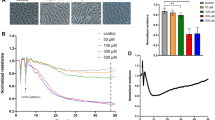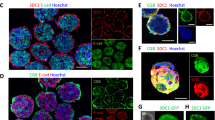Abstract
The use of nanoparticles in medicine is ever increasing, and it is important to understand their targeted and non-targeted effects. We have previously shown that nanoparticles can cause DNA damage to cells cultured below a cellular barrier without crossing this barrier. Here, we show that this indirect DNA damage depends on the thickness of the cellular barrier, and it is mediated by signalling through gap junction proteins following the generation of mitochondrial free radicals. Indirect damage was seen across both trophoblast and corneal barriers. Signalling, including cytokine release, occurred only across bilayer and multilayer barriers, but not across monolayer barriers. Indirect toxicity was also observed in mice and using ex vivo explants of the human placenta. If the importance of barrier thickness in signalling is a general feature for all types of barriers, our results may offer a principle with which to limit the adverse effects of nanoparticle exposure and offer new therapeutic approaches.
This is a preview of subscription content, access via your institution
Access options
Subscribe to this journal
Receive 12 print issues and online access
$259.00 per year
only $21.58 per issue
Buy this article
- Purchase on Springer Link
- Instant access to full article PDF
Prices may be subject to local taxes which are calculated during checkout






Similar content being viewed by others
References
The Project on Emerging Nanotechnologies. The Nanotechnology Consumer Products Inventory (Woodrow Wilson International Center for Scholars, 2008); available at http://www.nanotechproject.org/inventories/consumer.
Aitken, R. J., Chaudhry, M. Q., Boxall, A. B. A. & Hull, M. Manufacture and use of nanomaterials: current status in the UK and global trends. Occup. Med. 56, 300–306 (2006).
Xia, T., Li, N. & Nel, A. E. Potential health impact of nanoparticles. Annu. Rev. Public Health 30, 137–150 (2009).
Shvedova, A. A., Kagan, V. E. & Fadeel, B. Close encounters of the small kind: adverse effects of man-made materials interfacing with the nano-cosmos of biological systems. Annu. Rev. Pharmacol. Toxicol. 50, 63–88 (2010).
Abbott, N. J., Patabendige, A. A., Dolman, D. E., Yusof, S. R. & Begley, D. J. Structure and function of the blood–brain barrier. Neurobiol. Dis. 37, 13–25 (2010).
Huppertz, B. The anatomy of the normal placenta. J. Clin. Pathol. 61, 1296–1302 (2008).
Kibschull, M., Gellhaus, A. & Winterhager, E. Analogous and unique functions of connexins in mouse and human placental development. Placenta 29, 848–854 (2008).
Aplin, J. D., Jones, C. J. & Harris, L. K. Adhesion molecules in human trophoblast—a review. 1. Villous trophoblast. Placenta 30, 293–298 (2009).
Bhabra, G. et al. Nanoparticles can cause DNA damage across a cellular barrier. Nature Nanotech. 4, 876–883 (2009).
Parry, M. C. et al. Thresholds for indirect DNA damage across cellular barriers for orthopaedic biomaterials. Biomaterials 31, 4477–4483 (2010).
Smith, R. A. & Murphy, M. P. Animal and human studies with the mitochondria-targeted antioxidant MitoQ. Ann. NY Acad. Sci. 1201, 96–103 (2010).
Evans, W. H., De Vuyst, E. & Leybaert, L. The gap junction cellular internet: connexin hemichannels enter the signalling limelight. Biochem. J. 397, 1–14 (2006).
Evans, W. H. & Leybaert, L. Mimetic peptides as blockers of connexin channel-facilitated intercellular communication. Cell Commun. Adhes. 14, 265–273 (2007).
Mothersill, C. & Seymour, C. B. Radiation-induced bystander effects and the DNA paradigm: an ‘out of field’ perspective. Mutat. Res. 597, 5–10 (2006).
Cogan, N. et al. DNA damaging bystander signalling from stem cells, cancer cells and fibroblasts after Cr(VI) exposure and its dependence on telomerase. Mutat. Res. 683, 1–8 (2010).
Chen, S. et al. Mitochondria-dependent signalling pathway are involved in the early process of radiation-induced bystander effects. Br. J. Cancer 98, 1839–1844 (2008).
Gebicki, J. M. et al. Reduction of protein radicals by GSH and ascorbate: potential biological significance. Amino Acids 39, 1131–1137 (2010).
Hamanaka, R. B. & Chandel, N. S. Mitochondrial reactive oxygen species regulate cellular signaling and dictate biological outcomes. Trends Biochem. Sci. 35, 505–513 (2010).
Murphy, E. & Steenbergen, C. Mechanisms underlying acute protection from cardiac ischemia-reperfusion injury. Physiol. Rev. 88, 581–609 (2008).
Ghandhi, S. A., Ming, L., Ivanov, V. N., Hei, T. K. & Amundson, S. A. Regulation of early signaling and gene expression in the alpha-particle and bystander response of IMR-90 human fibroblasts. BMC Med. Genomics 3, 31 (2010).
Ivanov, V. N. et al. Radiation-induced bystander signaling pathways in human fibroblasts: a role for interleukin-33 in the signal transmission. Cell Signal. 22, 1076–1087 (2010).
Dayan, F. et al. Activation of HIF-1alpha in exponentially growing cells via hypoxic stimulation is independent of the Akt/mTOR pathway. J. Cell Physiol. 218, 167–174 (2009).
Arsham, A. M., Plas, D. R., Thompson, C. B. & Simon, M. C. Phosphatidylinositol 3-kinase/Akt signaling is neither required for hypoxic stabilization of HIF-1 alpha nor sufficient for HIF-1-dependent target gene transcription. J. Biol. Chem. 277, 15162–15170 (2002).
Asur, R., Balasubramaniam, M., Marples, B., Thomas, R. A. & Tucker, J. D. Involvement of MAPK proteins in bystander effects induced by chemicals and ionizing radiation. Mutat. Res. 686, 15–29 (2010).
Yao, K., Ye, P. P., Tan, J., Tang, X. J. & Shen Tu, X. C. Involvement of PI3K/Akt pathway in TGF-beta2-mediated epithelial mesenchymal transition in human lens epithelial cells. Ophthalmic Res. 40, 69–76 (2008).
Hwang, J. W., Jung, J. W., Lee, Y. S. & Kang, K. S. Indole-3-carbinol prevents H(2)O(2)-induced inhibition of gap junctional intercellular communication by inactivation of PKB/Akt. J. Vet. Med. Sci. 70, 1057–1063 (2008).
Ito, S. et al. PI3K/Akt signaling is involved in the disruption of gap junctional communication caused by v-Src and TNF-. Biochem. Biophys. Res. Commun. 400, 230–235 (2010).
Cronier, L. et al. Requirement of gap junctional intercellular communication for human villous trophoblast differentiation. Biol. Reprod. 69, 1472–1480 (2003).
Frendo, J. L. et al. Involvement of connexin 43 in human trophoblast cell fusion and differentiation. J. Cell Sci. 116, 3413–3421 (2003).
Mayhew, T. M. Villous trophoblast of human placenta: a coherent view of its turnover, repair and contributions to villous development and maturation. Histol. Histopathol. 16, 1213–1224 (2001).
Malassiné, A. & Cronier, L. Involvement of gap junctions in placental functions and development. Biochim. Biophys. Acta 1719, 117–124 (2005).
Warrell, D. A., Cox, T. M., Firth, J. D. & Benz, E. J. Jr. Oxford Textbook of Medicine (Oxford Univ. Press, 2009).
Simmons, D. G. et al. Early patterning of the chorion leads to the trilaminar trophoblast cell structure in the placental labyrinth. Development 135, 2083–2091 (2008).
Yamashita, K. et al. Silica and titanium dioxide nanoparticles cause pregnancy complications in mice. Nature Nanotech. 6, 321–328 (2011).
Keelan, J. A. Nanotoxicology: nanoparticles versus the placenta. Nature Nanotech. 6, 263–264 (2011).
Case, C. P. et al. Widespread dissemination of metal debris from implants. J. Bone Joint Surg. Br. 76, 701–712 (1994).
Hornof, M., Toropainen, E. & Urtti, A. Cell culture models of the ocular barriers. Eur. J. Pharm. Biopharm. 60, 207–225 (2005).
Reichl, S. Cell culture models of the human cornea—a comparative evaluation of their usefulness to determine ocular drug absorption in-vitro. J. Pharm. Pharmacol. 60, 299–307 (2008).
Baird, D. M., Rowson, J., Wynford-Thomas, D. & Kipling, D. Extensive allelic variation and ultrashort telomeres in senescent human cells. Nature Genet. 33, 203–207 (2003).
Freund, A., Orjalo, A. V., Desprez, P. Y. & Campisi, J. Inflammatory networks during cellular senescence: causes and consequences. Trends Mol. Med. 16, 238–246 (2010).
Davy, P., Nagata, M., Bullard, P., Fogelson, N. S. & Allsopp, R. Fetal growth restriction is associated with accelerated telomere shortening and increased expression of cell senescence markers in the placenta. Placenta 6, 539–542 (2009).
Biron-Shental, T. et al. Short telomeres may play a role in placental dysfunction in preeclampsia and intrauterine growth restriction. Am. J. Obstet. Gynecol. 202, 381.e1-7 (2010).
James, J. L., Whitley, G. S. & Cartwright, J. E. Pre-eclampsia: fitting together the placental, immune and cardiovascular pieces. J. Pathol. 221, 363–378 (2010).
Street, M. E., Volta, C., Ziveri, M. A., Viani, I. & Bernasconi, S. Markers of insulin sensitivity in placentas and cord serum of intrauterine growth-restricted newborns. Clin. Endocrinol. 71, 394–399 (2009).
Burton, G. J., Yung, H. W., Cindrova-Davies, T. & Charnock-Jones, D. S. Placental endoplasmic reticulum stress and oxidative stress in the pathophysiology of unexplained intrauterine growth restriction and early onset preeclampsia. Placenta 30(Suppl. A), S43–S48 (2009).
Yung, H. W., Charnock-Jones, D. S. & Burton, G. J. Regulation of AKT phosphorylation at Ser473 and Thr308 by endoplasmic reticulum stress modulates substrate specificity in a severity dependent manner. PLoS ONE 6, e17894 (2011).
Barbaric, I. et al. Novel regulators of stem cell fates identified by a multivariate phenotype screen of small compounds on human embryonic stem cell colonies. Stem Cell Res. 5, 104–119 (2010).
Olive, P. L., Wlodek, D., Durand, R. E. & Banath, J. P. Factors influencing DNA migration from individual cells subjected to gel electrophoresis. Exp. Cell Res. 198, 259–267 (1992).
Forbes, K., Baker, P. N., Aplin, J. D. & Westwood, M. IGF-I and -II regulate the life cycle of trophoblast in the developing human placenta. Am. J. Physiol. Cell Physiol. 294, C1313–C1322 (2008).
Hardin, J. W. & Hilbe, J. M. Generalized Linear Models and Extensions 2nd edn (StataCorp LP, 2007).
Acknowledgements
Advice and discussion was kindly provided by A. Halestrap (University of Bristol). P.W.A. and P.J.G. acknowledge support from the Wellcome Trust and from the Medical Research Council (project grant). The authors wish to thank O. Beaumont and L. Teoh for their help in calcium imaging experiments.
Author information
Authors and Affiliations
Contributions
C.P.C., A.S. and S.S. conceived and designed the experiments. A.S., S.S., L.L., B.H., R.G., E.W., D.R., P.G., C.A., K.F., M.W., I.P., M.B., R.J., M.S., D.B., G.L-C., L.C., J.L., K.S., M.L., L.R., H.S., M.B.M., A.R. and H.L. performed the experiments. C.P.C., R.N., D.R., P.G., N.M., J.A., A.R., M.B.M., J.H. and K.S. analysed the data. M.S., W.H.E., I.P. and E.I. contributed materials and analysis tools. C.P.C. wrote the paper.
Corresponding author
Ethics declarations
Competing interests
The authors declare no competing financial interests.
Supplementary information
Supplementary information
Supplementary information (PDF 1328 kb)
Rights and permissions
About this article
Cite this article
Sood, A., Salih, S., Roh, D. et al. Signalling of DNA damage and cytokines across cell barriers exposed to nanoparticles depends on barrier thickness. Nature Nanotech 6, 824–833 (2011). https://doi.org/10.1038/nnano.2011.188
Received:
Accepted:
Published:
Issue Date:
DOI: https://doi.org/10.1038/nnano.2011.188
This article is cited by
-
The in vitro toxicity evaluation of halloysite nanotubes (HNTs) in human lung cells
Toxicological Research (2021)
-
The Involvement of Cell Adhesion Molecules, Tight Junctions, and Gap Junctions in Human Placentation
Reproductive Sciences (2021)
-
Evaluation and comparison of the effects of biosynthesized selenium and silver nanoparticles using plant extracts with antifungal drugs on the growth of Aspergillus and Candida species
Rendiconti Lincei. Scienze Fisiche e Naturali (2021)
-
Recent insights on indirect mechanisms in developmental toxicity of nanomaterials
Particle and Fibre Toxicology (2020)
-
DNA damage signalling from the placenta to foetal blood as a potential mechanism for childhood leukaemia initiation
Scientific Reports (2019)



